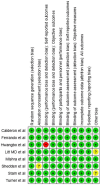Comparative evaluation of cognitive behavioural therapy versus standard treatment in temporomandibular disorders: A systematic review
- PMID: 39041325
- PMCID: PMC11934845
- DOI: 10.1111/joor.13792
Comparative evaluation of cognitive behavioural therapy versus standard treatment in temporomandibular disorders: A systematic review
Abstract
Background: Temporomandibular disorders (TMDs) are musculoskeletal and neuromuscular conditions affecting the temporomandibular joint and associated structures. Cognitive-behavioural therapy (CBT) has emerged as a potential intervention for TMDs, but its comparative effectiveness against standard treatments remains unclear. This systematic review aimed to evaluate and compare the efficacy of CBT versus standard treatment interventions in managing TMDs.
Methods: A comprehensive search was conducted across multiple databases using MeSH keywords and Boolean operators. Inclusion criteria encompassed clinical trials comparing CBT/CBT in combination with standard treatment interventions or a control group in individuals with TMDs. The primary outcome measured was pain. Secondary outcomes such as disability, depression and jaw function were also looked into. Two reviewers independently assessed for the eligibility of the articles and conducted data extraction. Quality assessments were performed using RoB 2.0 for randomised clinical trials.
Results: The initial search identified 623 articles, of which a total of eight clinical studies met the inclusion criteria and were included in the systematic review. Seven out of eight studies demonstrated improvements in outcomes related to TMD. Pain was significantly decreased in studies that showed a positive outcome. Jaw function, quality of life and psychological well-being were superior among individuals receiving CBT alone or in combination with conventional modalities, as well as hypnotic therapy coupled with CBT-based interventions. The quality of studies assessed showed all articles to be of good quality as per RoB-2 evaluation.
Conclusion: This systematic review highlights the potential benefits of CBT in managing TMDs, suggesting its effectiveness in improving pain outcomes and enhancing overall well-being. The findings indicate that CBT may be a valuable adjunct or alternative to standard treatment interventions for individuals with TMDs. However, further research with larger sample sizes and standardised outcome measures is warranted to establish definitive conclusions regarding the comparative efficacy of CBT versus standard treatments in TMD management.
Keywords: cognitive‐behavioural therapy; pain; temporomandibular disorders.
© 2024 The Author(s). Journal of Oral Rehabilitation published by John Wiley & Sons Ltd.
Conflict of interest statement
The authors declare no conflict of interest.
Figures
Similar articles
-
Psychological therapies for temporomandibular disorders (TMDs).Cochrane Database Syst Rev. 2022 Aug 11;8(8):CD013515. doi: 10.1002/14651858.CD013515.pub2. Cochrane Database Syst Rev. 2022. PMID: 35951347 Free PMC article.
-
Group cognitive behavioural therapy for postnatal depression: a systematic review of clinical effectiveness, cost-effectiveness and value of information analyses.Health Technol Assess. 2010 Sep;14(44):1-107, iii-iv. doi: 10.3310/hta14440. Health Technol Assess. 2010. PMID: 20863477
-
Cognitive-behavioural treatment for subacute and chronic neck pain.Cochrane Database Syst Rev. 2015 May 26;2015(5):CD010664. doi: 10.1002/14651858.CD010664.pub2. Cochrane Database Syst Rev. 2015. PMID: 26006174 Free PMC article.
-
Psychological therapies for panic disorder with or without agoraphobia in adults: a network meta-analysis.Cochrane Database Syst Rev. 2016 Apr 13;4(4):CD011004. doi: 10.1002/14651858.CD011004.pub2. Cochrane Database Syst Rev. 2016. PMID: 27071857 Free PMC article.
-
Occlusal interventions for managing temporomandibular disorders.Cochrane Database Syst Rev. 2024 Sep 16;9(9):CD012850. doi: 10.1002/14651858.CD012850.pub2. Cochrane Database Syst Rev. 2024. PMID: 39282765
Cited by
-
Physiotherapy Approaches for Temporomandibular Disorders: A Multimodal Conservative Management Strategy.Cureus. 2025 Jul 28;17(7):e88885. doi: 10.7759/cureus.88885. eCollection 2025 Jul. Cureus. 2025. PMID: 40881526 Free PMC article. Review.
References
-
- Paduano S, Bucci R, Rongo R, Silva R, Michelotti A. Prevalence of temporomandibular disorders and oral parafunctions in adolescents from public schools in southern Italy. Cranio. 2020;38:370‐375. - PubMed
-
- Iodice G, Cimino R, Vollaro S, Lobbezoo F, Michelotti A. Prevalence of temporomandibular disorder pain, jaw noises and oral behaviours in an adult Italian population sample. J Oral Rehabil. 2019;joor.12803:691‐698. - PubMed
-
- Gonçalves DA d G, Dal Fabbro AL, Campos JADB, Bigal ME, Speciali JG. Symptoms of temporomandibular disorders in the population: an epidemiological study. J Orofac Pain. 2010;24:270‐278. - PubMed
Publication types
MeSH terms
LinkOut - more resources
Full Text Sources
Medical
Miscellaneous




